-
Countries
-
Data and Analysis
-
Special Focus
-
Crisis Responses
Assessment Report
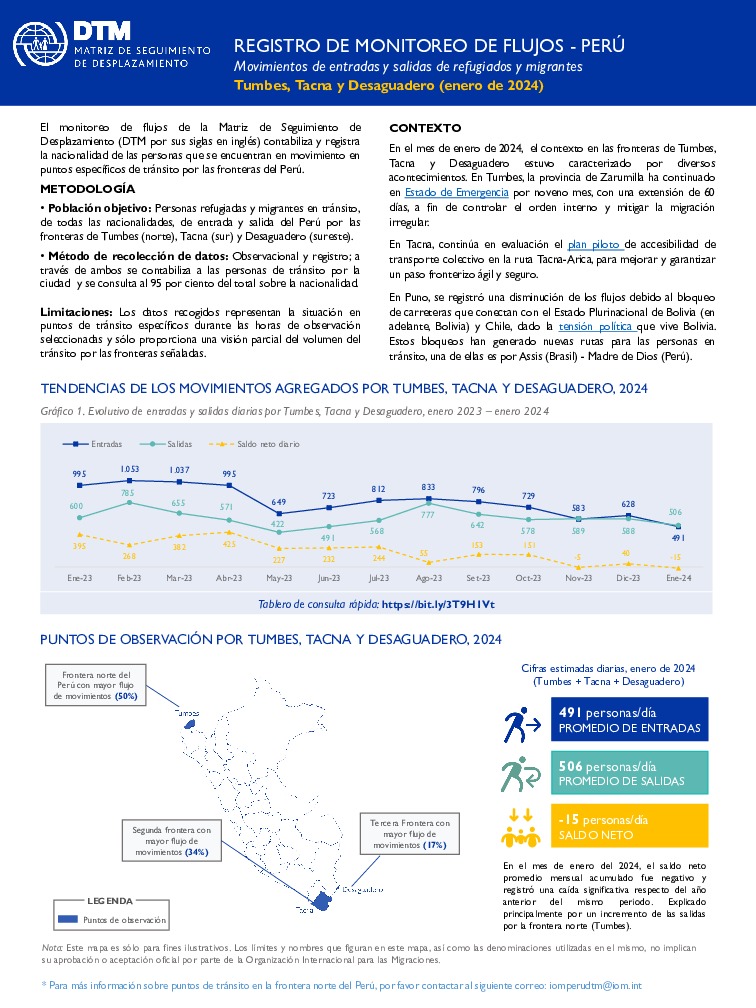
Contact
DTM Peru, IOMDTMPeru@iom.int
Language
Spanish
Location
Peru
Period Covered
Jan 01 2024
Jan 31 2024
Activity
- Flow Monitoring
En el mes de enero de 2024, el contexto en las fronteras de Tumbes, Tacna y Desaguadero estuvo caracterizado por diversos acontecimientos. En Tumbes, la provincia de Zarumilla ha continuado en Estado de Emergencia por noveno mes, con una extensión de 60 días, a fin de controlar el orden interno y mitigar la migración irregular. En Tacna, continúa en evaluación el plan piloto de accesibilidad de transporte colectivo en la ruta Tacna-Arica, para mejorar y garantizar un paso fronterizo ágil y seguro. En Puno, se registró una disminución de los flujos debido al bloqueo de carreteras que conectan con el Estado Plurinacional de Bolivia (en adelante, Bolivia) y Chile, dado la tensión política que vive Bolivia. Estos bloqueos han generado nuevas rutas para las personas en tránsito, una de ellas es por Assis (Brasil) - Madre de Dios (Perú).
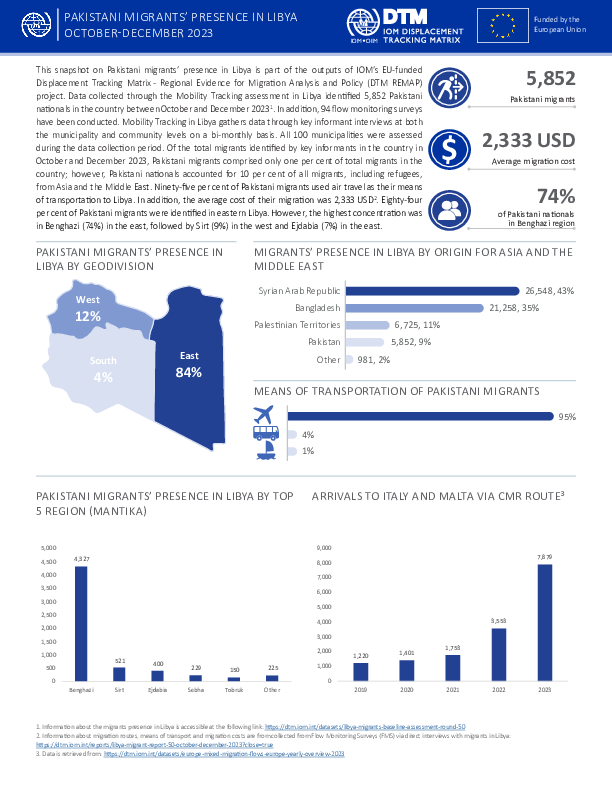
Contact
DTM Pakistan, iomisbdtmremapteam@iom.int; DTM Libya, DTMLibya@iom.int
Language
English
Location
Libya
Period Covered
Oct 01 2023
Dec 31 2023
Activity
- Survey
- Flow Monitoring Survey
- Mobility Tracking
- Baseline Assessment
This snapshot on Pakistani migrants’ presence in Libya is part of the outputs of IOM’s EU-funded Displacement Tracking Matrix - Regional Evidence for Migration Analysis and Policy (DTM REMAP) project. Data collected through the Mobility Tracking assessment in Libya identified 5,852 Pakistani nationals in the country between October and December 20231. In addition, 94 flow monitoring surveys have been conducted. Mobility Tracking in Libya gathers data through key informant interviews at both the municipality and community levels on a bi-monthly basis. All 100 municipalities were assessed during the data collection period. Of the total migrants identified by key informants in the country in October and December 2023, Pakistani migrants comprised only one per cent of total migrants in the country; however, Pakistani nationals accounted for 10 per cent of all migrants, including refugees, from Asia and the Middle East. Ninety-five per cent of Pakistani migrants used air travel as their means of transportation to Libya. In addition, the average cost of their migration was 2,333 USD2. Eighty-four per cent of Pakistani migrants were identified in eastern Libya. However, the highest concentration was in Benghazi (74%) in the east, followed by Sirt (9%) in the west and Ejdabia (7%) in the east.
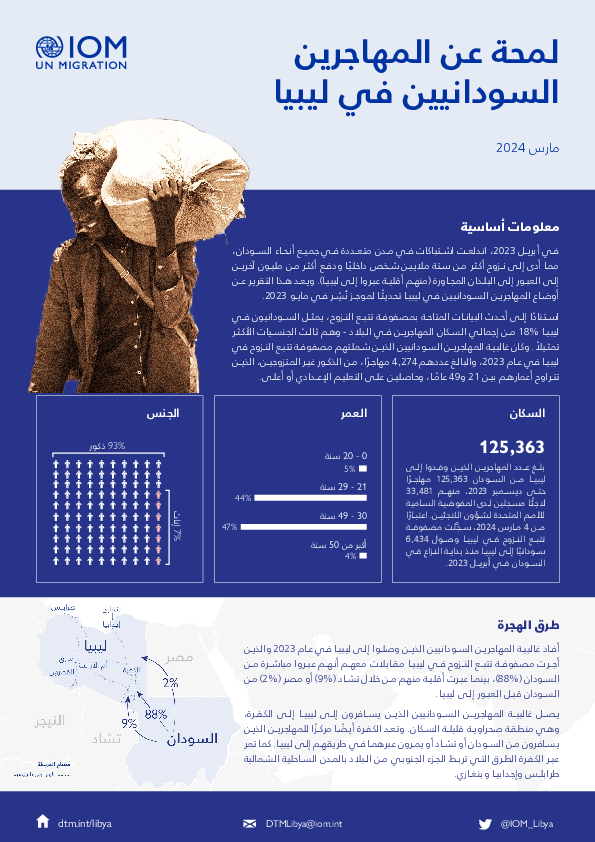
Contact
DTM Libya, DTMLibya@iom.int
Language
English
Location
Libya
Snapshot Date
Feb 29 2024
Activity
- Survey
- Flow Monitoring Survey
- Return Intention
- Flow Monitoring
يقدم هذا الملف معلومات عن وضع المهاجرين السودانيين في ليبيا ونقاط ضعفهم، بما في ذلك أولئك الذين وصلوا بعد بداية النزاع في منتصف أبريل 2023، ويقدم تحديثًا لموجز نُشر في مايو 2023.
تستند المعلومات المتعلقة بوضع المهاجرين ونقاط الضعف إلى مقابلات فردية كمية أجرتها مصفوفة تتبع النزوح في ليبيا مع 4,274 مهاجرًا في عام 2023، ما لم يُنص على خلاف ذلك. تستند أرقام المهاجرين إلى البيانات التي تم جمعها من خلال مقابلات مع مزودي المعلومات.

Contact
DTM Europe, DTMMediterranean@iom.int
Language
English
Location
Greece
Period Covered
Sep 06 2023
Dec 31 2023
Activity
- Survey
- Flow Monitoring
This report presents the results of the first round of the Displacement Tracking Matrix (DTM) Flow Monitoring Surveys (FMS) implemented in Greece since 2018. FMS provides a snapshot of the profiles, experiences and needs of migrants arriving by sea and by land and residing in reception centres of different kinds in Greece. The data was collected from 06 September to 31 December 2023 in 38 different Flow Monitoring Survey Points (FMPs), distributed in ten different regions of Greece. IOM interviewed a total of 916 individual respondents.
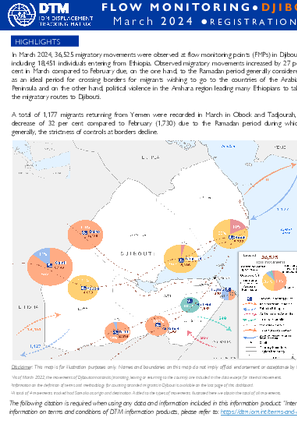
Contact
DTM Djibouti, DTMDjibouti@iom.int
Language
English
Location
Djibouti
Period Covered
Mar 01 2024
Mar 31 2024
Activity
- Flow Monitoring
In March 2024, 36,525 migratory movements were observed at flow monitoring points (FMPs) in Djibouti, including 18,451 individuals entering from Ethiopia. Observed migratory movements increased by 27 per cent in March compared to February due, on the one hand, to the Ramadan period generally considered as an ideal period for crossing borders for migrants wishing to go to the countries of the Arabian Peninsula and on the other hand, political violence in the Amhara region leading many Ethiopians to take the migratory routes to Djibouti.
A total of 1,177 migrants returning from Yemen were recorded in March in Obock and Tadjourah, a decrease of 32 per cent compared to February (1,730) due to the Ramadan period during which, generally, the strictness of controls at borders decline

Contact
DTM Europe, DTMMediterranean@iom.int
Language
English
Location
Bosnia & Herzegovina
Period Covered
Mar 01 2024
Mar 31 2024
Activity
- Flow Monitoring
This report provides insight into the latest migration trends and patterns in Bosnia and Herzegovina (BiH). IOM surveyed 829 migrants from 1 March to 31 March 2024 in transit reception centres (TRCs) as well as in key entry, transit and exit locations around the country. The report provides insights into the profiles, experiences, needs, routes travelled and intentions of migrants transiting through BiH.

Contact
DTM Europe, DTMMediterranean@iom.int
Language
English
Location
Bosnia & Herzegovina
Period Covered
Mar 01 2023
Mar 31 2024
Activity
- Flow Monitoring
This report provides insight into the latest migration trends and patterns in Bosnia and Herzegovina (BiH). IOM surveyed 829 migrants from 1 March to 31 March 2024 in transit reception centres (TRCs) as well as in key entry, transit and exit locations around the country. The report provides insights into the profiles, experiences, needs, routes travelled and intentions of migrants transiting through BiH.

Contact
DTM Djibouti, DTMDjibouti@iom.int
Language
French
Location
Djibouti
Period Covered
Mar 01 2024
Mar 31 2024
Activity
- Flow Monitoring
En mars 2024, 36 525 mouvements migratoires ont été observés aux points de suivi des flux (FMP) à Djibouti dont 18 451 individus entrants en provenance d’Éthiopie. Les mouvements migratoires observés ont augmenté de 27 pour cent en mars par rapport à février dû, d’une part, à la période de Ramadan, généralement considérée comme une période idéale de franchissement des frontières pour les migrants désireux de se rendre vers les pays de la Péninsule Arabique, et d’autre part, des violences politiques dans la région d’Amhara, conduisant beaucoup d’Éthiopiens à emprunter les routes migratoires vers Djibouti.
Un total de 1 177 migrants de retour du Yémen a été enregistré en mars à Obock et Tadjourah soit une baisse de 32 pour cent par rapport à février (1 730) en raison de la période de Ramadan pendant laquelle, généralement, la rigueur des contrôles aux frontières baisse
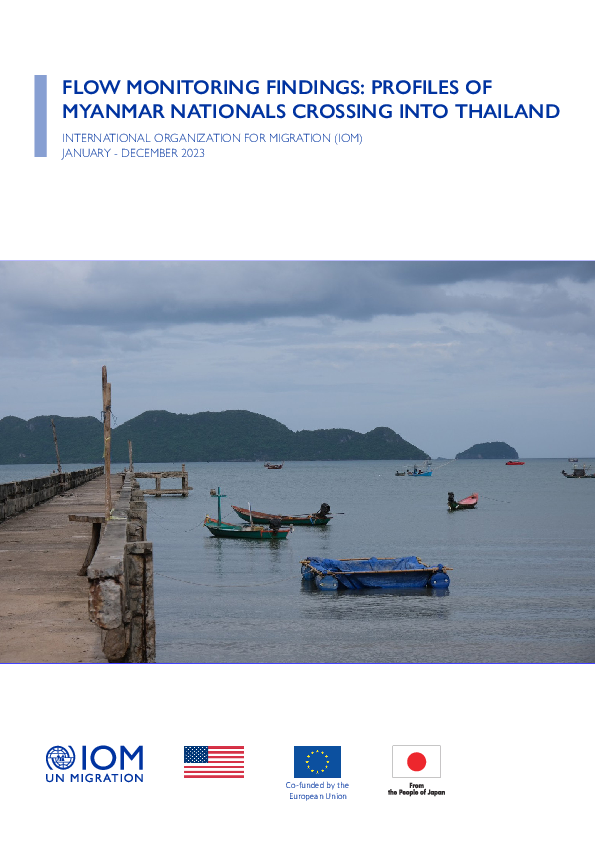
Contact
DTM Thailand, dtmthailand@iom.int
Language
English
Location
Thailand
Period Covered
Jan 01 2023
Dec 31 2023
Activity
- Survey
- Flow Monitoring
To gain a better understanding of the mobility dynamics and vulnerabilities of Myanmar nationals entering Thailand, IOM Thailand initiated flow monitoring activities at key points of entry (POEs) in Tak, Ranong, and Kanchanaburi border provinces in 2023 using IOM Displacement Tracking Matrix (DTM) tools. Flow monitoring aims track the scale and characteristics of Myanmar nationals’ mobility along the Myanmar-Thailand border, including the volume of movements and intended destinations of migrants, their reasons for movement, intended lengths of stay, and expectations about work sectors and conditions. The tool provides critical insights into current mobility dynamics in the context of the socio-economic and security situation in Myanmar following the military takeover in February 2021. The following report extends findings from the mid-year flow monitoring report published in September 2023. It covers the entire year of 2023 in Tak and Ranong, and additionally includes analysis of Kanchanaburi province from September to December 2023.
Flow Monitoring Counting (FMC) and Flow Monitoring Surveys (FMS) are conducted simultaneously at each point for one week every month. Tak, Kanchanaburi, and Ranong were chosen due to pre-existing information indicating that the three provinces experience a substantial volume of entries of Myanmar nationals.
From January to December 2023, IOM’s Migration Data and Research Unit (MDRU) interviewed a total of 4,693 incoming Myanmar nationals to Thailand, with 2,366 interviewed in Tak province (50%), 2,310 in Ranong province (49%), and 17 in Kanchanaburi province (1%).
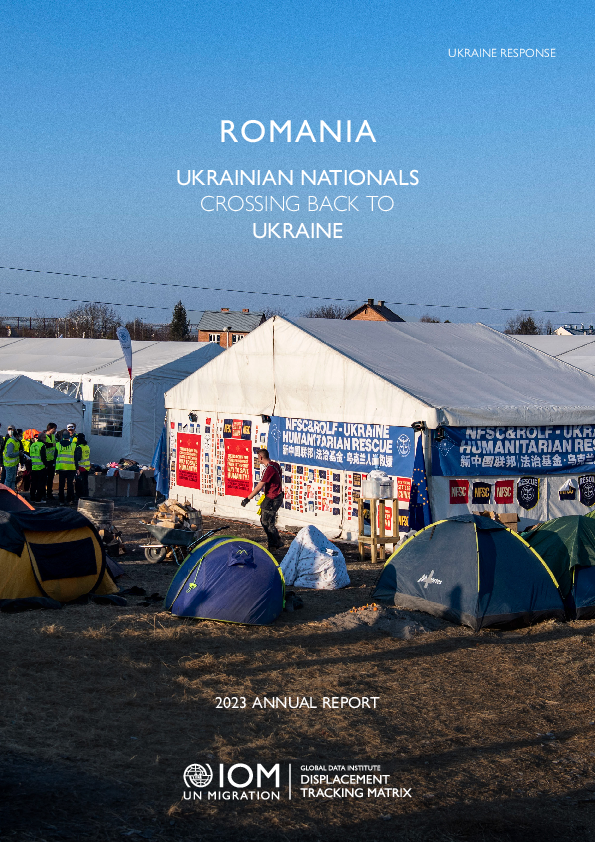
Contact
DTM Europe, DTMMediterranean@iom.int
Language
English
Location
Romania
Period Covered
Jan 01 2023
Dec 31 2023
Activity
- Survey
- Return Intention
- Flow Monitoring
This report employs data collected within the framework of the Crossing Back surveys conducted in Romania between January and December 2023 with Ukrainian nationals who were either crossing back for a short-time visit or returning for a long-term period to Ukraine from or through Romania. The analysis considers ‘’short-term visitors’’ those persons who intended to spend 0-30 days in Ukraine, while respondents planning to stay for more than a month are defined as “prospective returnees”.
The survey included answers from 5,773 Ukrainian nationals living in or passing through Romania who were travelling to Ukraine. Among those interviewed before crossing back into Ukraine, the majority stayed in Romania (59%), followed by Bulgaria (17%) or Germany (5%). Additional countries of residence included Italy (4%), the United Kingdom of Great Britain and Northern Ireland (3%), Türkiye (2%), Belgium (2%), Greece (1%), Austria (1%), with the remaining 6% distributed among other nations.
The travel intentions of the surveyed Ukrainian nationals show that most respondents (53%) were “short-term visitors”, while 27 per-cent were prospective returnees. Another 20 per cent were not sure regarding their visit period. Also, most UA citizens were travelling back to their oblast of origin (93%), with most respondents originating from Odeska, Chernivetska, Mykolaivska, Ivan-Frankivska, City of Kiyv and Kharvivska.
Pagination
- Previous page
- Page 33
- Next page
